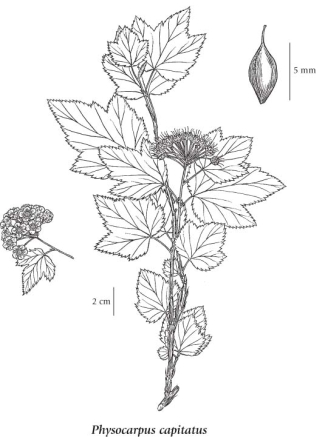Pacific ninebark
Rosaceae (Rose family)
Introduction to Vascular Plants
Species Information click to expand contents
General:
Medium to tall shrub, 1-4 m tall; branches erect to arching, angled, smooth to minutely star-shaped-hairy when young, eventually with brown, shredding bark.
Leaves:
Alternate, deciduous, the stalks 1-3 cm long, the blades egg- to heart-shaped in outline, 3-10 cm long, palmately 3- or 5-lobed, the lobes irregularly double-toothed, deeply veined, shiny dark green above, paler and with abundant star-shaped hairs below.
Flowers:
Inflorescences dense, terminal, half-rounded clusters of numerous stalked flowers, the stalks woolly; corollas white, saucer-shaped, the petals 5, nearly circular, 3-5 mm long; calyces densely star-shaped-hairy, 5-lobed, the lanceolate lobes about 3 mm long, somewhat bent back; ovaries superior; stamens about 30, pink.
Fruits:
Follicles, 3 to 5, barely joined at the base, inflated, 7-11 mm long, reddish, mostly smooth; seeds 1 to 4 per follicle, pear-shaped, yellowish, hardened, shiny.
Illustration click to expand contents

If more than one illustration is available for a species (e.g., separate illustrations were provided for two subspecies) then links to the separate images will be provided below. Note that individual subspecies or varietal illustrations are not always available.
Illustration Source: The Illustrated Flora of British Columbia
USDA Species Characteristics click to expand contents
Flower Colour:
White
Blooming Period:
Late Spring
Fruit/Seed characteristics:
Colour: Red
Present over the Summer
Source: The USDA
Ecology click to expand contents
The table below shows the species-specific information calculated from
original data (BEC database) provided by the BC Ministry of Forests and Range.
(Updated August, 2013)
| Site Information |
Value / Class |
||
|
Avg |
Min |
Max |
|
| Elevation
(metres) |
223 | 0 | 1325 |
| Slope
Gradient (%) |
6 | 0 | 90 |
|
Aspect (degrees) |
274 | 35 | 360 |
| Soil
Moisture Regime (SMR) [0 - very xeric; 4 - mesic; 8 - hydric] |
5 | 0 | 7 |
| Modal
Nutrient Regime
Class |
D | ||
| #
of field plots species was recorded in: |
96 | ||
| Modal
BEC Zone Class |
CWH | ||
|
All BEC Zones (# of stations/zone) species was recorded in |
CDF(13), CWH(66), ICH(4), IDF(3), PP(2) | ||
|
Source:
Klinkenberg 2013
|
|||
Habitat and Range click to expand contents
Status Information click to expand contents
Synonyms click to expand contents
Synonyms and Alternate Names:
Physocarpus opulifolius (L.) Maxim., orth. cons.
Physocarpus opulifolius var. tomentellus (Ser.) B. Boivin
Taxonomic Notes click to expand contents
Dwarf Pacific Ninebark
Pacific ninebark is a large shrub frequently reaching four meters in height, but the dwarf mutant grows to be only about one-half meter in height, with horizontal spreading branches. Such dwarf mutants may involve a mutation affecting the normal growth hormones in the plant, or they could affect some biosynthetic pathway that is necessary for normal growth. Despite its small size, the mutant produces normal leaves and flowers. Source: Extracted from Griffiths and Ganders, 1983, Wildflower Genetics: A Field Guide for British Columbia and the Northwest. |